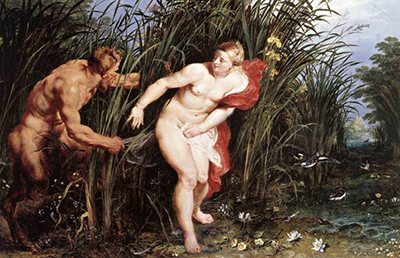Here we see the moment when the lecherous god Pan grasps out for the beautiful young nymph Syrinx as she attempts to keep away from the clutches of the lustful satyr.
Not one, but two, of the most acclaimed Old Masters of 17th century Flemish art worked for two years to create this captivating telling of one of the most lustful episodes of Greek mythology. Legend has it that as Pan returned from a trip to Mount Lycaeus he spotted the beautiful Syrinx and was determined to have her. Syrinx, however, was not impressed and immediately ran off into the lush undergrowth to escape.
Pan pursued his muse and caught her among a reed bed when a river blocked her escape. Just as he reached out to grab her, Syrinx's call for help was answered when a god transformed her into a new growth of sturdy reeds. Not to be thwarted, however, Pan decided to cut these reeds and take them with him. After noticing the reeds produced a musical note as the wind blew across them, Pan decided to cut them into different lengths, each making a different musical note when he blew across its end.
He then attached the cut reeds together in a row of ascending size (and decending musical pitch) thereby created the pipes that still bear his name today. The Greek mythological legends tell of how the beautiful Syrinx managed to protect her chastity but that she must forever sing Pan's tune when commanded. Today this type of instrument is still known as Pan Pipes but fewer now remember its other name - Syrinx.
In 1617, when Peter Paul Reubens settled upon the tragic tale of Syrinx and her determination to preserve her chastity from Pan's advances as the subject of his next major work, he called upon the assistance of another Old Master, Jan Brueghel the Elder, to guarantee the success of the artwork. This is because, while Reubens was confident of his composition and skill in figure painting, his old friend Brueghel was a skilled draftsman whose representations of flowers and foliage were particularly acclaimed so seemed to be the perfect collaborator for a story where reeds were a key component.
The pair were old friends and had already worked together on many commissions, bringing the Flemish partnership fame in the early years of the 17th century. Today their gripping depiction of Pan and Syrinx is in the public collection of Museumslandschaft Hessen, Germany.




